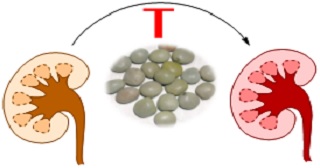Network Pharmacology Approach to Evaluate the Therapeutic Effects of Caesalpinia bonduc (L.) Components for the Nephroprotective Activity Natural Product Chemistry
Main Article Content
Abstract
Caesalpinia bonduc (L.) (Family: Caesalpiniaceae) commonly known as Bonduc Nut and Fever Nut is the main ingredients in Hjam-hbras formulation, a single herb formulation documented in Buddha Shakamuni for treating renal diseases. C. bonduc seed extract is also scientifically validated for having renal protective effects but its exact mechanism by which it showed renal protective effect is still unknown. In this study, we aimed to evaluate the nephroprotective mechanism of action of C. bonduc seed by performing Network pharmacology analysis. ADMET property analysis reveals 21 out of 190 phytochemicals of C. bonduc seeds has passed the good ADMET criteria. Network pharmacology analysis identified 197 mutual common nephroprotective targets for these 21 phytochemicals. The PPI analysis discovered that AKT1, PIK3CA, SRC, PIK3R1, HSP90AA1, MAPK1, PTPN11, FYN, EGFR and STAT3 are the top 10 genes sorted by degree value. GO enrichment analysis showed various processes, functions, and cellular components involved in nephroprotection while the KEGG enrichment analysis showed the associated pathways HIF-1 signaling pathway, Thyroid hormone signaling pathway etc. involved in nephroprotection. This study provides bioinformatic insights via Network pharmacology analysis could pave the way for understanding the effectiveness of C. bonduc as nephropotective agent.
Article Details

This work is licensed under a Creative Commons Attribution-NonCommercial-NoDerivatives 4.0 International License.
How to Cite
References
P. Basist, B. Parveen, S. Zahiruddin, G. Gautam, R. Parveen, M. A. Khan, A. Krishnan, M. Shahid, S. Ahmad. Potential nephroprotective phytochemicals: Mechanism and future prospects. J Ethnopharmacol., 2022, 283, 114743. https://doi.org/10.1016/j.jep.2021.114743
H. Shahin D. H., R. Sultana, J. Farooq, T. Taj, U. F. Khaiser, N. S. A. Alanazi, M. K. Alshammari, M. N. Alshammari, F. H. Alsubaie, S. M. B. Asdaq, A. A. Alotaibi, A. A. Alamir, M. Imran, S. Jomah. Insights into the uses of traditional plants for diabetes nephropathy: a review. Curr. Issues Mol. Biol., 2022, 44, 2887. https://www.mdpi.com/1467-3045/44/7/199
S. Chaurasia, V. S. Mahalwal, P. M. Chandrika. Ethano medicinal plants used as nephroprotective in different traditional medicine: A review. Res. J. Pharm. Technol., 2021, 14, 1183. https://doi.org/10.5958/0974-360X.2021.00211.0
R. Basu, S. Dasgupta, S. N. Babu, A. Noor. Medicinal Plants in the Indian Traditional Medicine and Current Practices. Bioprospecting of Tropical Medicinal Plants. 2023, 253-86. https://doi.org/10.1007/978-3-031-28780-0_9
A. Parveen, M. Ahmad, B. Parveen, R. Parveen, M. Iqbal. The traditional system of Unani medicine, its origin, evolution and Indianisation: A critical appraisal. Indian J. Tradit. Knowl., 2022, 21, 511.
S. Panda, N. Kaur. Harnessing Traditional Tribal Knowledge Treasure in India by Unlocking the Potential of Digital Platform. University News., 2023, 2023, 110. https://doi.org/10.5281/zenodo.10213022.
M. Hirwade. Protecting traditional knowledge digitally: a case study of TKDL. 2010.
W. J. A. Musa, N. Bialangi, A. K. Kilo, C. J. Lamangantjo, B. Situmeang, A. M. Ibrahim. Flavonoid glycoside compound from tombili seed (Caesalpinia bonducella) and its antioxidant activity. Rasayan J Chem., 2022, 15, 2237. http://doi.org/10.31788/RJC.2022.1547087
K. Pudhom, D. Sommit, N. Suwankitti, A. Petsom. Cassane Furanoditerpenoids from the Seed Kernels of Caesalpinia bonduc from Thailand. J Nat Prod., 2007, 70, 1542. https://doi.org/10.1021/np070330y.
A. N. Jadhav, N. Kaur, K. K. Bhutani. A new furanoditerpenoid marker for the distinction between the seeds of two species of Caesalpinia. Phytochem Anal., 2003,14, 315. https://doi.org/10.1002/pca.722.
T. Liu, X. Li, Z. Ning, S. Qi, H. Gao. Two new cassane-type diterpenoids from the seed kernels of Caesalpinia bonduc (Linn.) Roxb. and their anti-inflammatory activity. Nat Prod Res., 2022, 36, 3901. https://doi.org/10.1080/14786419.2021.1896511.
J. Cao, Y. Xu, R. Lou, W. Shi, J. Chen, L. Gan, J. Lu, L. Lin. Cassane-Type Diterpenoids from the Seeds of Caesalpinia bonduc (L.) Roxb. Chem Biodiversity., 2021, 18, e2100309. https://doi.org/10.1002/cbdv.202100309
S. Nithiyanandam, S. E. Prince. Caesalpinia bonducella mitigates oxidative damage by paracetamol intoxication in the kidney and intestine via modulating pro/anti-inflammatory and apoptotic signaling: an In vivo mechanistic insight. 3 Biotech., 2023, 13, 176. https://doi.org/10.1007/s13205-023-03601-3
A. K. Sachan, C. V. Rao, N. K. Sachan. Determination of antidiabetic potential in crude extract of caesalpinia bonducella wild on normal and streptozotocin induced diabetic rats. Res. J. Pharm. Technol., 2020, 13, 857. https://doi.org/10.5958/0974-360X.2020.00162.6.
S. Chakrabarti, T. K. Biswas, T. Seal, B. Rokeya, L. Ali, A. K. A. Khan, N. Nahar, M. Mosihuzzaman, B. Mukherjee. Antidiabetic activity of Caesalpinia bonducella F. in chronic type 2 diabetic model in Long-Evans rats and evaluation of insulin secretagogue property of its fractions on isolated islets. J Ethnopharmacol., 2005, 97, 117. https://doi.org/10.1016/j.jep.2004.10.025.
D. M. Kannur, V. I. Hukkeri, K. S. Akki. Antidiabetic activity of Caesalpinia bonducella seed extracts in rats. Fitoterapia. 2006, 77, 546. https://doi.org/10.1016/j.fitote.2006.06.013.
K. Simin, S. M. Khaliq-Uz-Zaman, V. U. Ahmad. Antimicrobial activity of seed extracts and bondenolide from Caesalpinia bonduc (L.) Roxb. Phytother Res., 2001, 15, 437. https://doi.org/10.1002/ptr.756.
K. Raveena, T. P. Jayachandran. Evaluation of ethanol extract of Caesalpinia bonducella L. seeds on Hyperthyroidism. J. Pharm. Sci. & Res., 2020, 12, 1420.
V. Kandasamy, U. Balasundaram. Caesalpinia bonduc (L.) Roxb. as a promising source of pharmacological compounds to treat Poly Cystic Ovary Syndrome (PCOS): A review. J Ethnopharmacol., 2021, 279, 114375. https://doi.org/10.1016/j.jep.2021.114375.
M. Sumithra, V. Chitra, M. K. Moka, Padaleeswaran, S. Ahmed. Anti - androgenic activity of Caesalpinia bonducella in androgen-induced polycystic ovarian syndrome rats. J Pharm Res Int., 2021, 33, 220. https://doi.org/10.9734/JPRI/2021/v33i55A33826
T. D. P. Rini, F. Sangande, K. Agustini, A. Bahtiar. Identification and analysis of Ardisia humilis as potential antihyperlipidemic by network pharmacology followed by molecular docking. Res. J. Pharm. Technol., 2024, 17, 2009. https://doi.org/10.52711/0974-360X.2024.00318.
J. -Q, Wang, X. -X. Liu, J. -J. Zhang, Z. Shuai, C. Jiang, S. -W. Zheng, Z. Wang, D. -Y. Li, W. Li, D. -F. Shi. Amelioration of Cisplatin-Induced kidney injury by Arabinogalactan based on network pharmacology and molecular docking. J. Funct. Foods., 2023, 104, 105504. https://doi.org/10.1016/j.jff.2023.105504.
S. Das, R. L Gajbhiye, N. Kumar, D. Sarkar. Multi-Targeted Prediction of the Antiviral Effect of Momordica charantia extract based on Network Pharmacology. J. Nat. Remedies., 2023, 23, 169. https://doi.org/10.18311/jnr/2023/31430.
C. Jia, X. Pan, B. Wang, P. Wang, Y. Wang, R. Chen. Mechanism Prediction of Astragalus membranaceus against Cisplatin-Induced Kidney Damage by Network Pharmacology and Molecular Docking. Evid Based Complement Alternat Med., 2021, 2021, 9516726. https://doi.org/10.1155/2021/9516726.
M. J. Alqahtani, S. A. Mostafa, I. A. Hussein, S. Elhawary, F. A. Mokhtar, S. Albogami, M. Tomczyk, G. E. S. Batiha, W. A. Negm. Metabolic Profiling of Jasminum grandiflorum L. Flowers and Protective Role against Cisplatin-Induced Nephrotoxicity: Network Pharmacology and In Vivo Validation. Metabolites., 2022, 12, 792. https://doi.org/10.3390/metabo12090792.
X. Li, J. Shi, Y. Teng, Z. Liu. The preventative effect of Baihe Gujin Pill on cisplatin-induced acute kidney injury by activating the PI3K/AKT and suppressing the NF-κB/MAPK pathways. J Ethnopharmacol., 2024, 318, 117071. https://doi.org/10.1016/j.jep.2023.117071.
Z. Liu, Y. Xu, X. Bai, L. Guo, X. Li, J. Gao, Y. Teng, P. Yu. Prediction of the mechanisms of action of Zhibai Dihaung Granule in cisplatin-induced acute kidney injury: A network pharmacology study and experimental validation. J Ethnopharmacol., 2022, 292, 115241. https://doi.org/10.1016/j.jep.2022.115241.
S. Pal, M. L. Yellurkar, P. Das, V. Sai Prasanna, S. Sarkar, R. L. Gajbhiye, R. Velayutham, S. Arumugam. A network pharmacology, molecular docking and in vitro investigation of Picrorhiza kurroa extract for the treatment of diabetic nephropathy. Journal of Biomolecular Structure and Dynamics., 2024, 1. https://doi.org/10.1080/07391102.2024.2314259.
X. Li, Q. Tang, F. Meng, P. Du, W. Chen. INPUT: An intelligent network pharmacology platform unique for traditional Chinese medicine. Computational and Structural Biotechnology Journal., 2022, 20, 1345. https://doi.org/10.1016/j.csbj.2022.03.006.
S. X. Ge, D. Jung, R. Yao. ShinyGO: a graphical gene-set enrichment tool for animals and plants. Bioinformatics., 2020, 36, 2628. https://doi.org/10.1093/bioinformatics/btz931.
F. Zhang, R. Wu, Y. Liu, S. Dai, X. Xue, Y. Li, S. Gong. Nephroprotective and nephrotoxic effects of Rhubarb and their molecular mechanisms. Biomedicine & Pharmacotherapy., 2023, 160, 114297. https://doi.org/10.1016/j.biopha.2023.114297.
C. -y. Fang, D. -y. Lou, L. -q. Zhou, J. -c. Wang, B. Yang, Q. -j. He, J. -j. Wang, Q. -j. Weng. Natural products: potential treatments for cisplatin-induced nephrotoxicity. Acta Pharmacologica Sinica., 2021, 42, 1951. https://doi.org/10.1038/s41401-021-00620-9.
L. Zhang, X. -p. Li, J. -q. Lai, L. Zhang, editors. Bioinformatics databases for network pharmacology research of traditional chinese medicine: A systematic review. 2017 IEEE International Conference on Bioinformatics and Biomedicine (BIBM); 2017: IEEE.
F. Noor, M. Tahir ul Qamar, U. A. Ashfaq, A. Albutti, A. S. Alwashmi, M. A. Aljasir. Network pharmacology approach for medicinal plants: review and assessment. Pharmaceuticals., 2022, 15, 572. https://doi.org/10.3390/ph15050572.
G. Xiong, Z. Wu, J. Yi, L. Fu, Z. Yang, C. Hsieh, M. Yin, X. Zeng, C. Wu, A. Lu, X. Chen, T. Hou. ADMETlab 2.0: an integrated online platform for accurate and comprehensive predictions of ADMET properties. Nucleic Acids Research., 2021, 49, W5-W14. https://doi.org/10.1093/nar/gkab255.
D. Gfeller, A. Grosdidier, M. Wirth, A. Daina, O. Michielin, V. Zoete. SwissTargetPrediction: a web server for target prediction of bioactive small molecules. Nucleic Acids Research., 2014, 42, W32-W8. https://doi.org/10.1093/nar/gku293.
M. -y. Liu, D. -x. Jiang, X. Zhao, L. Zhang, Y. Zhang, Z. -d. Liu, R. -z. Liu, H. -j. Li, X. -y. Rong, Y. -z. Gao. Exploration in the Mechanism of Ginsenoside Rg5 for the Treatment of Osteosarcoma by Network Pharmacology and Molecular Docking. Orthopaedic Surgery., 2024, 16, 462. https://doi.org/10.1111/os.13971.
X. Liu, S. Ouyang, B. Yu, Y. Liu, K. Huang, J. Gong, S. Zheng, Z. Li, H. Li, H. Jiang. PharmMapper server: a web server for potential drug target identification using pharmacophore mapping approach. Nucleic Acids Research., 2010, 38, W609-W14. https://doi.org/10.1093/nar/gkq300.
X. Xie, H. Lou, Y. Shi, G. Gan, H. Deng, X. Ma, M. Meng, X. Gao. A network pharmacological-based study of the mechanism of Liuwei Dihuang pill in the treatment of chronic kidney disease. Medicine., 2023, 102, e33727. https://doi.org/10.1097/MD.0000000000033727.
L. Zhang, S. Lu, Z. Hu, M. Liao, C. Li, S. Kong. Prediction of the anti-inflammatory effects of bioactive components of a Hippocampus species-based TCM formulation on chronic kidney disease using network pharmacology. Trop. J. Pharm. Res., 2021, 20, 2355. https://doi.org/10.4314/tjpr.v20i11.18.
P. Shannon, A. Markiel, O. Ozier, N. S. Baliga, J. T. Wang, D. Ramage, N. Amin, B. Schwikowski, T. Ideker. Cytoscape: a software environment for integrated models of biomolecular interaction networks. Genome Res., 2003, 13, 2498. https://doi.org/10.1101/gr.1239303.
R. Zhang, X. Zhu, H. Bai, K. Ning. Network pharmacology databases for traditional Chinese medicine: review and assessment. Front. Pharmacol., 2019, 10, 123. https://doi.org/10.3389/fphar.2019.00123.
J. Zhao, J. Yang, S. Tian, W. Zhang. A survey of web resources and tools for the study of TCM network pharmacology. Quantitative Biology., 2019, 7, 17. https://doi.org/10.1007/s40484-019-0167-8.
P. Shannon, A. Markiel, O. Ozier, N. S. Baliga, J. T. Wang, D. Ramage, N. Amin, B. Schwikowski, T. Ideker. Cytoscape: a software environment for integrated models. Genome Res., 1971, 13, 426. https://doi.org/10.1101/gr.1239303.
C. v. Mering, M. Huynen, D. Jaeggi, S. Schmidt, P. Bork, B. Snel. STRING: a database of predicted functional associations between proteins. Nucleic Acids Research., 2003, 31, 258. doi:https://doi.org/10.1093/nar/gkg034.
B. T. Sherman, M. Hao, J. Qiu, X. Jiao, M. W. Baseler, H. C. Lane, T. Imamichi , W. Chang. DAVID: a web server for functional enrichment analysis and functional annotation of gene lists (2021 update). Nucleic Acids Research., 2022, 50, W216-W21. https://doi.org/10.1093/nar/gkac194.
Q. Yang, S. Wang, E. Dai, S. Zhou, D. Liu, H. Liu, Q. Meng, B. Jiang, W. Jiang. Pathway enrichment analysis approach based on topological structure and updated annotation of pathway. Briefings in Bioinformatics., 2019, 20, 168. https://doi.org/10.1093/bib/bbx091.
G. O. Consortium. The Gene Ontology (GO) database and informatics resource. Nucleic Acids Research., 2004, 32, D258-D61. https://doi.org/10.1093/nar/gkh036.
M. Kanehisa, M. Furumichi, M. Tanabe, Y. Sato, K. Morishima. KEGG: new perspectives on genomes, pathways, diseases and drugs. Nucleic Acids Research., 2017, 45, D353-D61. https://doi.org/10.1093/nar/gkw1092.

